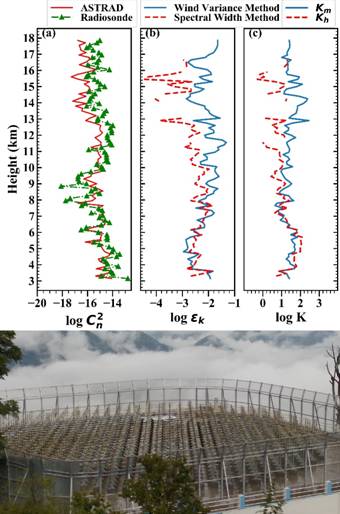ARIES scientists estimate turbulence parameters in the lower troposphere over the central Himalayan region for the first time
Weather predictions becoming more certainand help in preventing air traffic disasters may now be easier and, especially in the Himalaya region. Thanks to certain atmospheric turbulence parameters specific to the Himalaya region that scientists have calculated.
Scientists at the Aryabhatta Research Institute of Observational Sciences (ARIES), an autonomous institute under the Department of Science & Technology (DST), Govt. of India, have estimated turbulence parameters in the lower troposphere over the central Himalayan region for the first time.
The researchers have calculated the magnitude of refractive index structure (Cn2), a constant that represents the strength of the atmospheric turbulence using observation from their Stratosphere Troposphere Radar (S T Radar). In the study published in Radio Science journal led by Aditya Jaiswal, a Ph.D. student at ARIES Nainital and ARIES faculties D.V. Phani Kumar, S. Bhattacharjee, and Manish Naja have found that the refractive index structure constant (Cn2) is as large as 10-14 m-2/3. Such large values at the lower altitudes are due to the mountain wave activities and presence of low-level clouds.
Proper and timely information of the higher values of the atmospheric turbulence parameters and understanding of time and space distribution of turbulence structure in the troposphere could help improve performance of numerical weather prediction and climate models.
While the turbulence parameters for southern India were known earlier, the same were not known over the Himalayan region. Thus some approximate values were used by modelers for calculation. They have now been found to be much higher over the Himalayan region. Now modelers will be able to update these values in their existing models. This will help in improving weather predictions. Also, precise knowledge on turbulence over this region will help in safe air traffic movements.
It is also important to model clear-air turbulence as that would aid in limiting the air traffic disasters, particularly over the complex mountainous regions. Low levels of cloud are generated in a mountainous region with complex topography. Because of this, stable air in this region is set into oscillations known as mountain waves and lee waves. Characterization of turbulence in the mountainous region is vital to understand the dynamics of mountain induced wave disturbances and other related phenomena, which has crucial role in modulating the general circulation wind patterns.
Talking about the SERB, DST funded indigenously developed ST Radar used in the study, DST Secretary Professor Ashutosh Sharma said, “Development of such radar at 206.5 MHz, within the country, will further strengthen our efforts to better understand the regional changes in weather and climate, particularly in the Himalayan region, which is having complex topography.”

